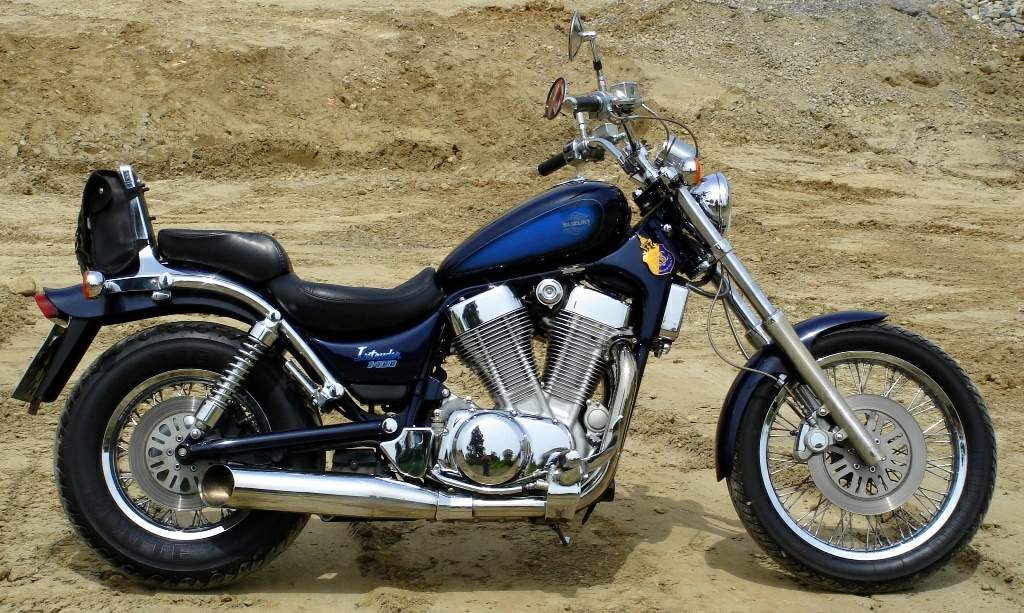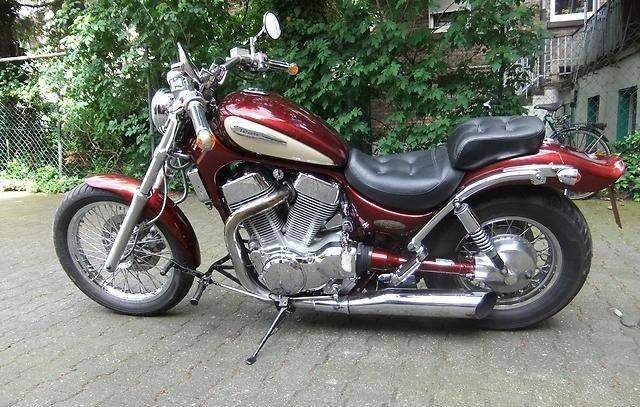
|
|
|
|
|
|
Classic Bikes
Custom Bikes
Individual
Racing Bikes AJP
AJS
Aprilia
Ariel
Avinton / Wakan
Bajaj
Benelli
Beta
Bimota
BMW
Brough Superior
BRP Cam-Am
BSA
Buell / EBR
Bultaco
Cagiva
Campagna
CCM
CF Moto
Combat Motors
Derbi
Deus
Ducati
Excelsior
GASGAS
Ghezzi Brian
Gilera
GIMA
Harley Davidson
Hero
Highland
Honda
Horex
Husaberg
Husqvarna
Hyosung
Indian
Jawa
Kawasaki
KTM
KYMCO
Laverda
Lazareth
Magni
Maico
Mash
Matchless
Mondial
Moto Guzzi
Moto Morini
MV Agusta
MZ / MuZ
NCR
Norton
NSU
Paton
Peugeot
Piaggio
Revival Cycles
Roland Sands
Royal Enfield
Sachs
Sherco
Sunbeam
Suzuki
SWM
SYM
Triumph
TVS
Ural
Velocette
Vespa
Victory
Vincent
VOR
Voxan
Vyrus
Walt Siegl
Walz
Wrenchmonkees
Wunderlich
XTR / Radical
Yamaha
Zero
Video
Technical
Complete Manufacturer List
|
Suzuki VS 1400GL Intruder
 Since its introduction in 1987, Suzuki's Intruder has been a heavy hitter among big V-twin cruisers. It has run with or out-muscled all the other big twins, even though some of them boasted more displacement than its 1360cc, enjoyed liquid-cooling instead of the Intruder's air/oil heat-dispersal system, had more valves than the Suzuki's two intake and single exhaust valve, or employed an additional gearbox cog with five speeds to the Suzuki's four. For 1997, Suzuki quietly changed that final item, sliding five-speed transmission shafts and shift mechanism into an otherwise unchanged Intruder engine-transmission unit. The new gearbox, previously fitted to European models, retains the same ratios for first through third gears but lowers (raises numerically) fourth gear a tad (from 25/24 or 1.041 to 25/23 or 1.086) and brings a new fifth gear which is slightly taller (24/25 or .96) than the old fourth gear was. Although the modification hasn't radically altered the Intruder's personality, the changes are almost entirely beneficial. With the recent increases in posted highway speeds, the more relaxed engine speed is particularly welcome. The change in top-gear ratio drops engine speed by about 300 rpm at 70 mph. It also brings a slight increase in fuel mileage, which on the five-speed reached 51 mpg on some rides on open road. That's a 5 mpg increase over the four-speed 1400 we tested early this year in our first Big Twins Comparison. Our average fuel consumption also improved, rising from 42.6 to 46.8 with the five-speed bike. That translates to an additional 10 or 15 miles between fuel stops. Taller gearing doesn't noticeably diminish the big Intruder's drive past slower traffic when you reach for a handful of throttle in top gear. The clocks at the dragstrip say it is 5.5 mph slower (76.7 mph instead of 82.2 mph) after 200 yards when accelerating from 50 mph, but unlike the change in engine tempo, the difference in top-gear acceleration is not discernible from the saddle. When you twist the throttle wide open, the five-speed Intruder feels like it leaps ahead just as enthusiastically as the four-speeder out on the highway. The overall gearing is still lower that monst other big twins'. We expected -- and got -- little change in all-out quarter-mile performance with the five-speed bike because fourth gear barely comes into play. Although early Intruder 1400s laid down quarter-mile performances in the high 12-second bracket with terminal speeds around 100 mph, our '96 machine turned in a best of just 13.71 seconds with a terminal speed of 93.2. We assumed that Suzuki had fitted calmer cams or made some other change along the way. This bike was just fractionally swifter at 13.64 seconds and 94.7 mph. If anything, the five-speed gearbox shifts more crisply than our last four-speed model. We had no shifting problems, and neutral was easy to locate. Perhaps because we didn't use it quite as hard or as long, this bike's clutch did not develop the grabbiness we experienced with our '96 machine. Carburetion is just a little flat off the bottom, and the power characteristics are slightly cammier than other big twins, though it still has adequate power from idle. Even around town it feels muscular and ready to rip if called upon. Though the 1400 doesn't have the top-end rush of its 800 stablemate, it still revs well and pulls hard at higher rpm. Once you get beyond the power delivery, the new Intruder is entirely familiar. Aside from an improved seal in the head-pipe/muffler junction, nothing outside the transmission case has changed. You get the same familiar Intruder that was such a sensation 10 years ago. The basis of its svelte style is a frame so narrow it passes inside the swingarm at its pivot. The tall, slender 110/90-21 front tire, long, raked-out 41mm fork stanchions, small headlight, pulled-back handlebar, tall cylinders and narrow seat and 3.4-gallon tank all conspire to give the Intruder a long, lean look. The influence of American chopper builders is evident. The 45-degree V of the engine isn't obscured by air cleaners, oil lines or other clutter, and both carburetors burrow out of view, one at the top of the engine, the other behind it. Shaft drive simplifies the appearance of the rear end. The clean, clever, compact packaging continues throughout the bike, which hides as many hoses, wires and ugly components as possible. The pieces you can see have a finished appearance. The rear brake hose, for example is stainless steel up in its forward section (where it doesn't have to flex). Many fasteners have caps or covers, and seams are placed out if view. It's the sort of look you'd get if you had a customizer in the design process. Although -- or maybe because -- it is original and unique, the look isn't for everybody. The narrow, raked-out chopper-style lines don't mesh with everyone's idea of what a cruiser should like. Nor do they suit every rider's idea of ideal cruiser ergonomics, particularly for long rides on the open road. The riding position is cramped for long stints. The bars pull back too close to the step in the saddle, and the saddle itself offers limited real estate for shifting your position. Taller riders get bent into a slouch. Even smaller riders complain that the pullback bars push their elbows into their stomachs during tight turns and place their wrists and an unnatural angle. The handlebar also sets you up in the wind, requiring greater than average pressure to hold your position against the air pressure at speed. Unless you fit a windshield, you get a good upper-body workout on long rides at highway speeds. In town or at lower speeds, the seating situation is less of an issue. Though limited front-to-back, the saddle is otherwise about average, narrow enough to make it handy around down and initially cushy but completely out of its depth on long rides. Though the saddle is adequate through the first tank, you reach bottom after a couple of hours of non-stop use. Coupled with the narrow frame, the saddle minimizes the obstacles your legs have to clear to reach the pavement, making short-legged folks feel secure. Because the big Intruder has been around and unchanged for so long, the aftermarket has plenty of alternative saddles to offer, whether you want something wide and plush or thin and swoopy. Passengers appreciate the security offered by the small backrest, but their accommodations are somewhat tight, both in terms of seat space and leg room. Passengers report the pillion becomes uncomfortable after half an hour or so. By using offset crankpins in the 45-degree engine, Suzuki loses some of that traditional exhaust beat but effectively suppresses vibration. No one complains about getting buzzed on the 1400. No one raved about the handling either. Between the awkward bend of the handlebar and what we call "floppy" steering at very low speed -- a tendency for the front fork to fall toward the steering locks -- the 1400 isn't very handy at low speeds. The considerable rake (36 degrees) and trail (6.54 inches) keep the steering from getting particularly light when you get up above a walking speed, despite the narrow front tire. Though it's stable enough on the highway or running around town, soft spring and damping rates and appreciable shaft effect (the tendency to rise and fall with power changes) impede its cornering manners. The soft suspension also means that it dives significantly during braking, though with such stable geometry, this isn't much of a problem. Our bike suffered from a mushy front brake, which isn't typical in our experience. There is acceptable power available from the single-disc front brake when the mush is exorcised; the front tire's traction is normally the limiting factor. The disc rear brake provides good control and power. The brake aside, our Intruder was otherwise trouble-free, which is what we expect from such a proven design. Maintenance poses no particular challenges once you learn how to get to air filters, battery and valves. Shaft drive certainly helps keep the rear end clean and also reduces maintenance compared to a chain. Its clean style, the long production run and the enthusiasm of owners have fostered good aftermarket support for the Intruder 1400. It enjoys a wider range of aftermarket accessories and replacement parts than any other Japanese current big twin. From oversize tanks and a frame kit to tiny chrome accents to brakes to hop-up parts, there is plenty available for the owner who wants to put his own stamp on the Intruder or simply erase some of its blemishes. Not a great choice, at least in stock form, for blasting to the next state or flying down twisty roads, the big Intruder is nonetheless an effective urban assault weapon, with strong power and head-turning looks. Ride it to work or take it out trolling on Friday nights and it will thrill you. The price, a miserly $8499, is certainly right. That puts it below all other big twins and some 1100s and not much above the most expensive 800 V-twin. Considering the level of quality, that's a bargain. What you save can be applied to altering any pieces that don't quite fit your requirements. It's certainly less than you'd spend trying to make one of those slower big twins keep up with the Intruder. 
|
|
|
Any corrections or more information on these motorcycles will be kindly appreciated. |